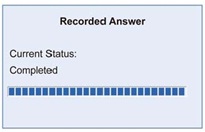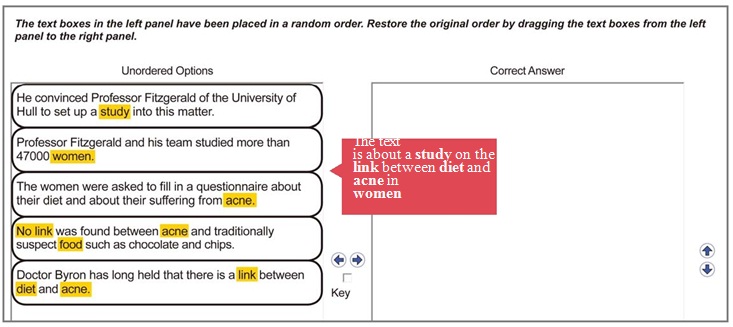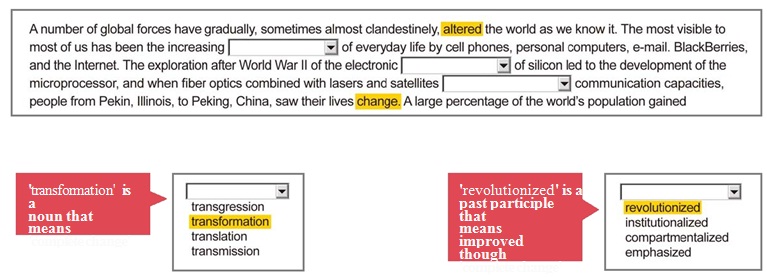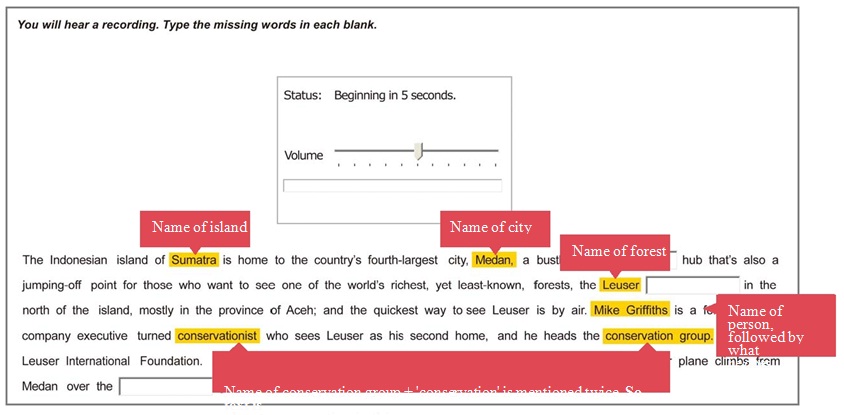Mẹo thi PTE điểm cao
Thứ Ba - 01/09/2015
Important Test Tips
Do
Use correct punctuation for writing tasks: full stops, capital letters, commas, etc.
Answer the question. If the question asks you to write or speak about sport, write or speak about ‘sport’ NOT ‘science’.
Keep strictly within the word limit given for writing tasks.
Respond quickly and keep speaking during speaking tasks. The microphone will close after 3 seconds of silence and stop recording.
Don’t
Write ENTIRELY in capital letters. Only use capitals when needed: at the beginning of sentences, names, etc.
Click Next (N) before you have completed the task and are ready to move on
Introduction to Test Tips
This resource provides a wealth of test tips for anyone preparing for PTE Academic. You can use the information to help develop useful strategies to answer the 20 item types in PTE Academic.
Two tips are included for most item types and they are presented in the order in which they appear in the test as follows:
| Speaking | Describe image |
| Re-tell lecture | |
| Answer short question | |
| Writing | Summarize written text |
| Write essay | |
| Reading | Multiple choice, choose single answer |
| Multiple choice, choose multiple answers | |
| Re-order paragraphs | |
| Reading: Fill in the blanks | |
| Reading & writing: Fill in the blanks | |
| Listening | Summarize spoken text |
| Multiple choice, choose multiple answers | |
| Fill in the blanks | |
| Highlight correct summary | |
| Multiple choice, choose single answer | |
| Select missing word | |
| Highlight incorrect words | |
| Write from dictation |
SPEAKING: Read aloud
Use punctuation to help you decide where to pause when you read
You have 30-40 seconds to look at the text before the microphone opens, so use this time to break the text up into meaningful
chunks, using the punctuation as a guide. This will show you the places where you can make a tiny pause and alter your intonation – going up when you begin reading a chunk and falling a little when you end a chunk.
Using appropriate pausing helps you to read more fluently and give the full meaning of the text. This will improve your score. Look at
where the pauses / are indicated in the example:
| Photography’s gaze widened during the early years of the twentieth century / and, / as the snapshot camera became increasingly popular, / the making of photographs became increasingly available / to a wide cross-section of the public. / The British people grew accustomed to, / and were hungry for, / the photographic image. |
Stress the words that carry important information
When you read the text, stress the words that help to convey meaning, by reading them in a slightly louder voice and adding emphasis to key syllables, e.g., development. Also use rising and falling intonation patterns to show how the ideas are linked or are coming to
an end. Look at the patterns in this text; the stressed words are underlined, and the rising and falling intonation is marked by up and
down arrows:
| The development of easy-to-use statistical software has changed the way statistics is being taught and learned . Students can make transformations of variables , create graphs of distributions of variables , and select among statistical analyses all at the click of a button . However , even with these advancements , students sometimes find statistics to be an arduous task . |
SPEAKING: Repeat sentence
Listen to the phrasing of the sentence as it is read aloud
You will be scored on the correct word sequences that you produce for this item type, so the more phrases you understand, the
better your reproduction of the sentence will be. For example, there are three phrases in this sentence, separated by /, and each
one carries a separate message that has its own meaning:
| Next week’s tutorial / on Tuesday / has been cancelled. |
If you listen for meaningful phrases in the sentence, you will have a better chance of repeating what you hear accurately.
Copy the stress and intonation patterns of the sentence you hear
Make a mental note of the way the speaker uses stress and intonation on the recording. These patterns help to convey the
meaning. Speak calmly and clearly, copying this stress and intonation. For example, look at the pattern in the example: the
stressed words or syllables are underlined, and the falling intonation is marked by down arrows:
| I’m going to attend the briefing for students |
SPEAKING: Describe image
Focus on the main information in the image
When you look at the image ask yourself ”What is the main idea being shown by the image?” and ”What are the details relating to the
main ideas?”. Use your erasable noteboard booklet to note down key ideas and phrases that relate to the main information and
the explanatory details. These can be put into sentences when you start to speak:
SPEAKING: Describe image
Organize your description of the image
If you organize what you say, you will get a better score. This is because a well-organized answer is more likely to cover the main
information as well as the additional details, and also talk about implications or conclusions based on the information. Look
at how this sample description is organized:
SPEAKING: Re-tell lecture
Make good use of the image to predict the topic of the lecture
You have 3 seconds before you listen to the recording to quickly look at the image on the screen. Use this time to think about the
vocabulary you might hear. This will give you an idea of the topic of the lecture and help you predict what you will hear when
the recording begins:
SPEAKING: Re-tell lecture
Make good use of the 40 seconds speaking time
You only have 40 seconds to speak and make sure that you include all the main points of the lecture. If you repeat ideas, correct
yourself or hesitate, you will use up valuable time and lose score points. So keep talking and ignore any mistakes that you make.
SPEAKING: Answer short question
Do not pause for too long when you answer the question
You hear a short question and then the recording status box will change to recording.
Start your answer as soon as this happens. If you wait for more than 3 seconds, recording will stop and the item status will change to ‘completed’, which means that you have lost your chance to give your answer.
When you have started talking, don’t stop for more than a second or two until you
have finished. If you stop for 3 seconds whilst speaking, the recording status will
change to ‘completed’ even if you haven’t finished, and you won’t be able to continue answering.
If the status changes to ‘completed’, you have to click ‘Next’ to move on to the next
item. This also applies to speaking item types Read aloud, Repeat sentence, Describe image and Re-tell lecture.
SPEAKING: Answer short question
Do not try to give a long answer
The instructions for this item type tell you how to answer the question:
There is no point in saying more than you need to say. Marks are awarded for a short, accurate answer. There are no extra marks for additional words.
For example, for this question: ‘What type of periodical is published on a daily basis?’, both these answers would score the same marks:
| newspapers It’s newspapers that are published every day. |
WRITING: Summarize written text
Make sure your response is in the correct form
When you have written your response, check to make sure that it is only one sentence, with a capital letter at the beginning and only one full stop at the end.
Your response must be between 5 and 75 words so check the word count using the ‘Total Word Count’ counter below the
response box. If you write fewer than five words or more than 75 words, your response will not be scored:
WRITING: Summarize written text
Practice using compound and complex sentences
Your response must be expressed within one sentence, so you will need to use a complex or compound sentence to be able to
summarize the main point of the passage and also briefly mention the supporting detail. For example, look at the clause
structures used in these summaries to link supporting ideas to the main point:
WRITING: Write essay
Start by analyzing the task
Before you write anything, note key words in the prompt. Find out the topic, what key points you should focus on to answer the
question and any points of view to present and discuss:
Analyzing these four areas will help you to approach the task, structure your essay and decide on your main ideas.
The content of your answer is very important. If you do not write about the topic in the prompt, you will receive no score points at all for this item type.
WRITING: Write essay
Analyze the essay prompt so you know how to answer
Essay prompts can be written in a number of ways. For example, you may need to discuss whether you agree or disagree with a
statement:
You may need to argue for and against an opinion or discuss advantages and disadvantages of a situation. If there is a statement followed by a question, read the question very carefully and note key words. Make sure you know what to do.
READING: Multiple choice, choose single answer
Note the key words in the prompt before you read the text
The prompt for this item type may be a question or a sentence that you have to complete. Whatever type of prompt you get, read it
carefully because it will tell you what information you need to find in the text. If you focus on the key words in the prompt, you will find the answer more quickly and spend less time reading the text.
READING: Multiple choice, choose single answer
Evaluate the response options
Answer is here.
The response options may be words, phrases or sentences. Use your own knowledge to decide whether any of them are unlikely to
be correct, or likely to be correct. You can do this before you read the text. If you read the text but cannot answer the question,
choose the option that you think is most likely to be correct. This strategy also applies to multiple-choice questions with more than one answer.
READING: Multiple choice, choose multiple answers
Make sure you know how the task is scored
Read the instructions carefully. Remember that more than one option is correct in this type of multiple choice item. You will score
marks for any correct options but you will lose score points for any incorrect options. These include: options that you have clicked on as correct but which are wrong and options that are correct but that you have not clicked on. If you click on all the options, because you do not know the answer, you will lose score points. This applies to Multiple choice, choose multiple answers item types for reading and listening.
READING: Multiple choice, choose multiple answers
Note any repeated words in the options
Quickly read through the response options and note any words that are repeated, particularly adjectives (e.g., ‘multigrade’) or nouns (e.g., ‘classes’). If the same noun phrase occurs in a lot of the options, the answer is probably related to this phrase.
Scan the text for the repeated words. Then read around them to find the answer more quickly:
READING: Re-order paragraphs
Read all the text boxes quickly before you start re-ordering them
Read the text boxes in order to understand the main idea of each one. You can do this by noting the key words.
Next, use the key words to form an overall idea of what the original text is about. This will help you find the logical order for the
ideas in the text boxes:
READING: Re-order paragraphs
Find the topic sentence first
Every well-written paragraph has a topic sentence. It is usually a clear statement about the topic, and all the other sentences are related in some way to this sentence.
The topic sentence can stand alone; it does not begin with a linker or a pronoun that refers back to something or someone
(e.g., ‘he’ or ‘this’), nor does it does refer back to information or actions previously mentioned through the use of things like
passive verb tenses (‘No link was found’):
READING: Fill in the blanks
Think about words that you often see or hear together
Remember that some words often go together to form a familiar phrase. This is called ‘collocation’. Using collocation can help you
recognize the correct word for each blank. For example, the phrase ‘the general public’ is a common collocation, so you can quickly
see that ‘public’ might be a good choice for the first blank in the sentence below:
READING: Fill in the blanks
Use your knowledge of grammar to help you select the correct word
Read around the blank in the text and decide what part of speech the missing word is. In the example below, ‘beginning to’ tells
you that an infinitive verb form is missing ‘to + verb’. Next look at the answer options provided and rule out any words that are not the right part of speech, e.g., ‘world’ is a noun and ‘formal’ is an adjective. Also rule out any verbs that are not in the infinitive form. Finally, choose from the words that are left, the one that has the correct meaning: ‘view’ and ‘look’ mean ‘see’, but we ‘quote’ or
‘cite’ references, so only ‘cite’ fits the blank:
READING & WRITING: Fill in the blanks
Skim for overall meaning to help you choose the correct word
Understanding the meaning of the whole text helps you choose the correct word for each blank. For example, if you skim the passage below, you will find key ideas and words which point to a main topic of ‘change’.
When you click on the drop down arrows, you may find options that are also related to the main topic. You can then check grammar
and overall meaning to see whether the words fit the blanks:
READING & WRITING: Fill in the blanks
Read before and after the blank to help you identify the correct word
The choices in the drop-down menus may look quite similar but will have different meanings and usage. Looking at the surrounding
context will help you choose the appropriate word. In the example below, only ‘access’ fits in the phrase ‘gained ¼¼¼¼. to
technologies’; pick words that match the meaning (gain access) and grammar (‘access to’). Reading either side of the blank will
help you narrow down the choices you have to make:
LISTENING: Summarize spoken text
Make sure you summarize the main point and include the supporting points
When you take notes using an erasable noteboard booklet, whilst you listen to the recording, make sure you note down the supporting
points as well as the main idea. From your notes, you can then summarize the main point and refer briefly to the essential supporting points, which will gain you good marks for content.
LISTENING: Summarize spoken text
Remember to check grammar, spelling and punctuation
In your 50-70 word summary, you will be scored on the enabling skills of grammar, spelling and vocabulary. So leave yourself 1-2 minutes after you have written your summary to check your sentences for things like subject/verb agreement, tenses and word order.
Use grammatical structures that you can use confidently, and words that you are sure you have spelled correctly. Finally, check
your punctuation: check full stops and commas, and make sure you have begun each sentence with a capital letter:
LISTENING: Multiple choice, choose multiple answers
Take notes of the main points and supporting details
In the 7 seconds before the recording begins, read the question and get ready to take notes to help you answer. Taking notes is likely
to be more helpful than trying to select options while you listen because you may not hear the information in exactly the same order as the options.
Note down details (e.g., times, places, things that happened) as well as the main points, because you will need to select more than
one option:
LISTENING: Multiple choice, choose multiple answers
Select for meaning, not just to match the words you hear
Select the options that best match the meaning of what you have heard. Don’t just choose an option because it has the same
words or phrases as the recording. Several options may use words from the recording but may not match the meaning of what you have heard.
LISTENING: Fill in the blanks
Skim the text before the recording begins
In the 7 seconds before the recording begins, you only have time to skim the text. As you do this, ignore the gaps and try to get an overall idea of what the text is about. This will help you recognize the words that fit the gaps, as you hear them.
Some of the things you can look for:
• Proper nouns (that begin with a capital letter). They can give you information about people and what they do (e.g., ‘Mike
Griffiths ¼ conservationist’), places (e.g., ‘Indonesian island of Sumatra’) and organizations (e.g., ‘conservation group The Leuser
International Foundation’). (Don’t worry if you don’t know where or who they are).
• Nouns that are repeated in the text. They may help you decide on the topic.
LISTENING: Fill in the blanks
As you listen, write the words you hear for the blanks on your ‘erasable noteboard booklet’
The recording is at normal speed and is only played once. When you are listening, you do not have time to think about how to spell the
missing words. Use your erasable noteboard booklet to write down what you think you hear:
After the recording has finished, you can read through the text, and use your notes to decide on the words that are missing and
how they are spelled. Then type them into the gaps:
Remember, the next item does not start until you click Next (N) at the bottom of the screen, so you have a little time to think about your answers.
LISTENING: Highlight correct summary
Take notes and match them to the correct summary
Don’t read the options before or while you are listening to the recording as there is too much to read, and this will distract you. Instead,
note down the key ideas on your erasable noteboard booklet as you listen (e.g., key words and phrases, numbers, names and dates
and any information that is highlighted by the speaker through stress and intonation). Then read the options and match the option that
is closest in detail to your notes:
LISTENING: Multiple choice, choose single answer
Focus on the kind of information you need
For listening multiple-choice questions, the main part of the question tells you what to listen for. Being aware of the focus of the question will help guide your listening.
For example, it will tell you whether you are listening for the main idea: What was the main cause of the company’s collapse?
Or listening for some supporting information or details: What aspect of past transport policy does the speaker mention?
Or listening for an inference drawn by the speaker: What does the speaker suggest that the factory may have to do?
Or listening for the speaker’s purpose: Why does the speaker talk about the fall in car ownership?
LISTENING: Multiple choice, choose single answer
Skim the question and answer options before you listen to understand the topic
In the 5 seconds before the recording begins, quickly
read the question and answer options to make sure you understand the topic.
For example, in the sample, the question shows that the speaker will talk about the future, and the options show
you they all include the word ‘media’. So you are
listening to hear what the speaker thinks will happen to the media in the future.
LISTENING: Select missing word
Know what to do if you change your mind about the answer
For each item in this task, there are three to five response
options but only ONE option is correct. At the end of the recording, click on the option you think is correct.
The next recording does not begin playing until you click
‘Next’. So you have a little time to think about your answer. If
you want to change your answer, click on it again to
‘de-select’ it. Then click on the option you think is correct.
LISTENING: Highlight incorrect words
Quickly read the transcription before you listen to focus on key words
In the 10 seconds before the recording begins, you cannot read word-for-word, but you can skim the transcription.
Focus on the words that give you information: e.g., nouns (‘economy’), adjectives (‘industrial’) and verbs (‘manufactured’). Decide what
the general topic is. This will help you pick out words that do not fit this topic area, as you read and listen:
LISTENING: Highlight incorrect words
Follow the text with the cursor as you listen
In this item type, you have to select the wrong words as the text is read. Don’t try to make notes as you listen.
Move the cursor along the screen as the words are spoken, and click on any words that sound different from the words on the screen:
LISTENING: Write from dictation
Type as many correct words as you can remember into the response box in the
correct order
You will score points for every correct word that you write in the response box. If you can remember a word but you are not sure where it
goes in the sentence, use your knowledge of English grammar to help you decide:
Tag xem thêm: du hoc uc, du hoc my, du hoc anh







































